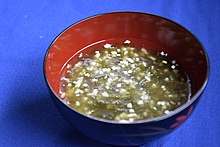Monostroma
Monostroma is a genus of marine green algae (seaweed) in the family Monostromataceae.[1] As the name suggests, algae of this genus are monostromatic (single cell layered). Monostroma kuroshiense, an algae of this genus, is commercially cultivated in East Asia and South America for the edible product "hitoegusa-nori" or "hirohano-hitoegusa nori", popular sushi wraps. Monostroma oligosaccharides with degree of polymerization 6 prepared by agarase digestion from Monostroma nitidum polysaccharides have been shown to be an effective prophylactic agent during in vitro and in vivo tests against Japanese encephalitis viral infection. The sulfated oligosaccharides from Monostroma seem to be promising candidates for further development as antiviral agents.[2] The genus Monostroma is the most widely cultivated genus among green seaweeds.
| Monostroma | |
|---|---|
_(14780855412).jpg) | |
| Monostroma hariotii | |
| Scientific classification | |
| Phylum: | Chlorophyta |
| Class: | Ulvophyceae |
| Order: | Ulotrichales |
| Family: | Monostromataceae |
| Genus: | Monostroma Thuret |
| Selected species | |
| |
Classification
Species-level classification within this genus is quite problematic and no consensus exists among algal taxonomists. This genus is oftentimes referred as "Gayralia", however Gayralia and Monostroma are congeneric. A number of monostromatic algal species have been removed from this genus, including Kornmannia, Ulvopsis and Capsosiphon. Currently accepted working-classification of monostromatic green algae[3] is provided as a figure. A taxonomic field-identification dichotomous key for this genus is available [4]
Genetics
Largest phylogeographic assessment of this genus yet conducted in SW Japan revealed existence of sympatric speciation in a panmictic population; the first report of sympatric speciation in algae[5]
Ecophysiology, cultivation and life cycle
A number of peer-reviewed scientific literature exists on the ecophysiology of this algal genus.[6] Natural and cultivated sexually reproducing environmental samples, as well as sexually reproducing and serendipitously discovered asexually reproducing ecotypes of monostromatic green alga from Tosa Bay, Japan are conspecific (belong to the same species).[7] Patterns of seasonal fluctuations in its thallus lengths were habitat specific and recur annually.[8] Both appearance and decay of thalli were earlier at high saline habitats, suggesting that salinity positively influences either maturation of sporophytes or senescence of gametophytes. Results from life cycle, thallus ontogeny, gametangial ontogeny and phylogenetic analyses suggest that this algal genus is evolutionarily affiliated in the order Ulotrichales.[9] Type of life cycle is not a valid diagnostic character for the species circumscription in Monostromataceae[10]
Reproduction and sex-ratio
Gametogenesis in this alga occurs in discontinuous patches along the frontal apex and the gametes release synchronously in a posterior faced linear fashion by the dehiscence of gametangial sheath, leading to the thallic disintegration.[11] The overall primary sex ratio of this alga is about 1:1 which is likely to reflect Fisherian selection.[12]
Culinary use

In Korea, edible Monostroma species such as Monostroma nitidum are called parae (파래), and eaten as a namul vegetable.
In Japan, dried Monostroma kuroshiense called aonori is used to season dishes such as takoyaki and okonomiyaki. In Okinawa, it is used in a soup called āsa nu ushiru.
References
- See the NCBI webpage on Monostroma. Data extracted from the "NCBI taxonomy resources". National Center for Biotechnology Information. Retrieved 2007-03-19.
- Kazłowski B, Chiu YH, Kazłowska K, Pan CL, Wu CJ (August 2012). "Prevention of Japanese encephalitis virus infections by low-degree-polymerisation sulfated saccharides from Gracilaria sp. and Monostroma nitidum". Food Chem. 133 (3): 866–74. doi:10.1016/j.foodchem.2012.01.106.
- Bast, F. 2011. Monostroma: the Jeweled Seaweed for Future. LAP LAMBERT Academic Publishing GmbH & Co. KG, 66121 Saarbrücken, Germany:
- Bast, F. 2012. Systematics and Taxonomic Keys for the Marine Green Algal Family Monostromataceae. In D. M. Krueger, H (Ed.), Algae: Ecology, Economic Uses and Environmental Impact (pp. 105-120).Nova Publishers New York. 105-120
- BAST, F., KUBOTA, S. AND OKUDA, K. 2014. Phylogeographic Assessment of Panmictic Monostroma Species from Kuroshio Coast, Japan Reveals Sympatric Speciation. Journal of Applied Phycology. DOI:10.1007/s10811-014-0452-x
- Bast, F. 2011. Monostroma: the Jeweled Seaweed for Future. LAP LAMBERT Academic Publishing GmbH & Co. KG, 66121 Saarbrücken, Germany:
- Bast, F., Shimada, S., Hiraoka, M., & Okuda, K. 2009. Asexual life history by biflagellate zoids in Monostroma latissimum (Ulotrichales). Aquatic Botany, 91: 213-218.
- Bast, F., Shimada, S., Hiraoka, M., & Okuda, K. 2009. Seasonality and thallus ontogeny of edible seaweed Monostroma latissimum (Kützing) Wittrock (Chlorophyta, Monostromataceae) from Tosa Bay, Kochi, Japan. Hydrobiologia, 630: 161-167.
- Bast, F. (2010). Comparative Ecophysiology and Phylogeography of Monostroma in Southern Japan. Ph.D., Kochi University, Japan.
- Bast, F. 2011. Monostroma: the Jeweled Seaweed for Future. LAP LAMBERT Academic Publishing GmbH & Co. KG, 66121 Saarbrücken, Germany:
- Bast, F., & Okuda, K. 2010. Gametangial Ontogeny in Intertidal Green Alga: Monostroma latissimum (Kützing) Wittrock. International Journal of Plant Reproductive Biology, 2: 11-15.
- Bast, F., Hiraoka, M., & Okuda, K. 2009. Spatiotemporal Sex Ratios of a Dioecious Marine Green Alga: Monostroma latissimum (Kützing) Wittrock. International Journal on Algae., 11: 141-150.